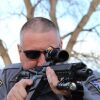The PoliceOne Academy features courses on firearms training, tactics and handling, as well as defensive tactics, subject control and de-escalation for law enforcement officers. Complete the courses to improve and retain critical skills to help improve your safety in the field. Visit PoliceOne Academy to learn more and for an online demo.
Early in my career when I’d hear about – or in today’s world, see the video of – a cop’s firearm mishap or poor shooting decision, I would be interested in the details and backstory of the incident. Now, as a firearms instructor, I’m more curious about the officer’s training.
Think back on some of the more memorable gun flubs from the public realm or even personal experience. Would additional training or additional repetitions of existing training have helped?
As instructors we give a lot of lip service to the importance of range training. We fight for extra time and ammunition so we may train our officers outside of the mandatory annual qualification course. However, it’s less common to hear discussion of the preparation required to make that range training successful.
High-quality firearms classroom training is important
Live-fire practice and training can be greatly enhanced by high-quality classroom instruction before going to the range. This is especially true since I am seeing fewer shooting enthusiasts entering law enforcement. The further we get students in the classroom, the more they benefit from range time. Well-constructed and executed classroom instruction leads to improvement in students’ overall firearms skills if the didactic – sit down or lecture - training is looked at as less of a prerequisite for and more as an augmentation to range training.
Here are three things we can do to reduce the risk of a firearm mishap or poor shooting decision without ever leaving the classroom:
- Trigger finger discipline;
- Draw from duty holster;
- CCW holstering.
1. Trigger finger discipline
First look at the area of most importance: Safety. Almost every unintentional discharge could have been avoided with better trigger finger discipline. Regardless of whether the accident happened while holstering, drawing, or attempting to pick up a downed gun if the trigger wasn’t pressed, the discharge would not have happened.
Telling students in class to keep their fingers off the trigger until they are ready to fire only goes so far. Most cops I know are good at trigger discipline as far as that statement goes. Specifically, their finger is off the trigger, but not necessarily, “in register.” In other words, it is not high up on the frame or (even better) the slide where it should be to avoid inadvertently entering the trigger guard during a slip, trip, fall or startle response. In my experience, this happens to most shooters who do not get a solid foundation and/or who do not get continuing education on the topic.
Hands-on classroom activity: Here’s a technique I’ve seen used successfully. Have the students pass around training pistol replicas (dummy guns) during lecture time. Students are responsible for both trigger finger and muzzle discipline. This activity helps to cement those principles in the students’ minds before beginning more practical exercises.
[RELATED: Take Police1’s 30 days to better firearms skills challenge]
2. Drawing from a duty holster
A lot of oops moments occur while the duty pistol is being drawn or holstered. Another advantage of a quick and efficient draw stroke is the student has more time to shoot deliberately. That’s a good thing both for training and that moment for which we are training.
This is another area where dummy guns really shine. I don’t recommend students drill with “live” firearms in the classroom.
Hands-on classroom activity: Conduct draw stroke practice in several short periods throughout the classroom training rather than one long block. Doing too much at one time will cause fatigue and fatigue is detrimental to physical skill-building.
3. Plainclothes/CCW holster
Adding a reasonable amount of training in plainclothes and off-duty holsters to your training program is a good idea. Most if not all departments provide training for drawing and holstering from duty gear. I know of very few who do the same for off-duty and plainclothes CCW holsters. Again, think about the firearm/holster mishaps of which you are aware. How many of them occurred with duty holsters and how many occurred with plainclothes gear? How much training does your department devote to non-uniform gear, if any?
Hands-on classroom activity: Have students bring their own CCW holsters. Go over the proper draw stroke and safe holstering methods with the class and then have them practice. It’s a great idea for the department to have several safe, quality but still affordable holsters for officers to try. This is a perfect way to ensure your cops are using good equipment and methods while carrying off-duty.
Conclusion
Quick drills that reinforce the lecture material and engage the student’s psychomotor domain are important for retention and building competency. Engaging the student in the material by beginning the physical skills in the classroom greatly enhances the student’s ability to learn during live-fire training. What are your favorite classroom activities for students on their way to the firearms range?
















